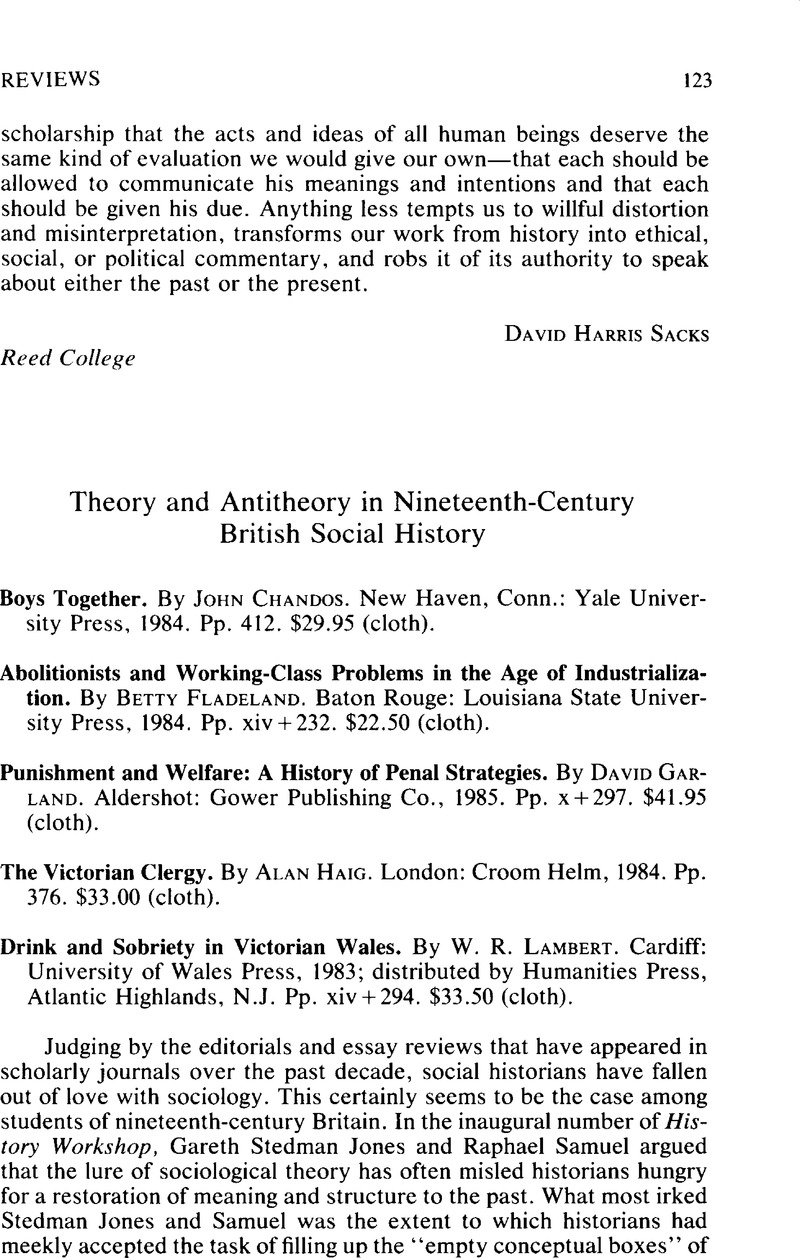No CrossRef data available.
Article contents
Theory and Antitheory in Nineteenth-Century British Social History - Boys Together. By John Chandos. New Haven, Conn.: Yale University Press, 1984. Pp. 412. $29.95 (cloth). - Abolitionists and Working-Class Problems in the Age of Industrialization. By Betty Fladeland. Baton Rouge: Louisiana State University Press, 1984. Pp. xiv + 232. $22.50 (cloth). - Punishment and Welfare: A History of Penal Strategies. By David Garland. Aldershot: Gower Publishing Co., 1985. Pp. x + 297. $41.95 (cloth). - The Victorian Clergy. By Alan Haig. London: Croom Helm, 1984. Pp. 376. $33.00 (cloth). - Drink and Sobriety in Victorian Wales. By W. R. Lambert. Cardiff: University of Wales Press, 1983; distributed by Humanities Press, Atlantic Highlands, N.J. Pp. xiv + 294. $33.50 (cloth).
Published online by Cambridge University Press: 10 January 2014
Abstract

- Type
- Reviews
- Information
- Journal of British Studies , Volume 26 , Issue 1: England's Foreign Relations , January 1987 , pp. 123 - 132
- Copyright
- Copyright © North American Conference of British Studies 1987
References
1 Samuel, Raphael and Jones, Gareth Stedman, “Sociology and History,” History Workshop 1 (Spring 1976): 6–7CrossRefGoogle Scholar.
2 Thompson, E. P., The Making of the English Working Class (London, 1963), pp. 10–11Google Scholar.
3 Jones, Gareth Stedman, “Class Expression versus Social Control? A Critique of Recent Trends in the Social History of ‘Leisure,’” History Workshop (Autumn 1977): 164–65Google Scholar.
4 Wiener, Martin J., review of Social Control in Nineteenth Century Britain, ed. Donajgrodzki, A. P., Journal of Social History 12 (Winter 1978): 316Google Scholar.
5 Thompson, F. M. L., “Social Control in Victorian Britain,” Economic History Review 34 (May 1981): 190–91CrossRefGoogle Scholar.
6 See, e.g., Moorhouse, H. F., “History, Sociology and the Quiescence of the British Working Class: A Reply to Reid,” Social History 4 (October 1979): 484–86CrossRefGoogle Scholar; and Hay, J. R., “Employers' Attitudes to Social Policy and the Concept of ‘Social Control,’ 1900–1920,” in The Origins of British Social Policy, ed. Thane, Pat (London, 1978), pp. 109–10Google Scholar.
7 Ross, Edward A., Social Control: A Survey of the Foundations of Order (New York, 1901)Google Scholar. By “social control” Ross meant those “disciplinary agents” that prevent “disruptive collisions” between individuals.
8 The best general discussion of Victorian moral reform is in Harrison, Brian, “State Intervention and Moral Reform in Nineteenth-Century England,” in Pressure from Without in Early Victorian England, ed. Hollis, Patricia (London, 1974)Google Scholar. On the theme of respectability in working-class culture, see Laqueur, Thomas, Religion and Respectability: Sunday Schools and Working Class Culture, 1780–1850 (New Haven, Conn., 1976)Google Scholar.
9 McKendrick, Neil, “Home Demand and Economic Growth: A New View of Women and Children in the Industrial Revolution,” in Historical Perspectives: Studies in English Thought and Society in Honour of J. H. Plumb, ed. McKendrick, Neil (London, 1974), pp. 170–71Google Scholar.
10 The definitive work on temperance in the period of 1815–72 is in Harrison, Brian, Drink and the Victorians (London, 1971)Google Scholar. A more narrowly conceived but useful account of the United Kingdom Alliance is in Dingle, A. E., The Campaign for Prohibition in Victorian England (London, 1980)Google Scholar.
11 E. P. Thompson (n. 2 above), pp. 12–13.
12 Smith, F. B., The People's Health, 1830–1910 (New York, 1979)Google Scholar; Joyce, Patrick, Work, Society and Politics: The Culture of the Factory in Later Victorian England (London, 1980)Google Scholar; Scull, Andrew, Museums of Madness (New York, 1979)Google Scholar; Walkowitz, Judith, Prostitution and Victorian Society (New York, 1980)CrossRefGoogle Scholar; Samuel, Raphael, ed., East End Underworld: Chapters in the Life of Arthur Harding (London, 1981)Google Scholar; Humphries, Stephen, Hooligans or Rebels: An Oral History of Working-Class Childhood and Youth (Oxford, 1981)Google Scholar.
13 Another recent study that deals with many of the same issues is Honey, J. R. de S., Tom Brown's Universe: The Development of the Victorian Public School (London, 1977)Google Scholar.
14 Russell, Anthony, The Clerical Profession (London, 1980)Google Scholar, takes precisely this approach in discussing eleven roles associated with the early nineteenth-century Anglican clergyman. Two recent works that treat “professionalization” with greater conceptual rigor are Duman, Daniel, The Judicial Bench in England, 1727–1875: The Reshaping of a Professional Elite (London, 1982)Google Scholar; and Engel, A. J., From Clergyman to Don: The Rise of the Academic Profession in Nineteenth-Century Oxford (Oxford, 1983)Google Scholar. The best survey of the subject remains Reader, W. J., Professional Men: The Rise of the Professional Classes in Nineteenth-Century England (London, 1966)Google Scholar.
15 Trollope, Anthony, The Bertrams (New York, 1867), p. 84, as quoted in EngelGoogle Scholar.
16 See Woods, Robert, “Mortality Patterns in the Nineteenth Century,” in Urban Disease and Mortality in Nineteenth-Century England, ed. Woods, Robert and Woodward, John (London, 1984)Google Scholar; and Bohstedt, John, Riots and Community Politics in England and Wales, 1790–1810 (Cambridge, Mass., 1983)CrossRefGoogle Scholar.
17 Stone, Lawrence, “Prosopography,” in Historical Studies Today, ed. Gilbert, Felix and Graubard, Stephen (New York, 1972), p. 110Google Scholar.
18 Two notable exceptions are Ignatieff, Michael, A Just Measure of Pain: The Penitentiary in the Industrial Revolution, 1750–1850 (New York, 1978)CrossRefGoogle Scholar; and Weeks, Jeffrey, Sex, Politics and Society: The Regulation of Sexuality since 1800 (London, 1981)Google Scholar.
19 Garland chooses the term “penality” to refer “to the whole of the penal complex, including its sanctions, institutions, discources and representations” (p. x).
20 Report of the Home Office Committee on the management, administration, classification and treatment of Prisoners (London, 1895)Google Scholar.
21 See Foucault, Michel, Discipline and Punish: The Birth of the Prison (London, 1977)Google Scholar; and Donzelot, Jacques, The Policing of Families (London, 1979)Google Scholar.




